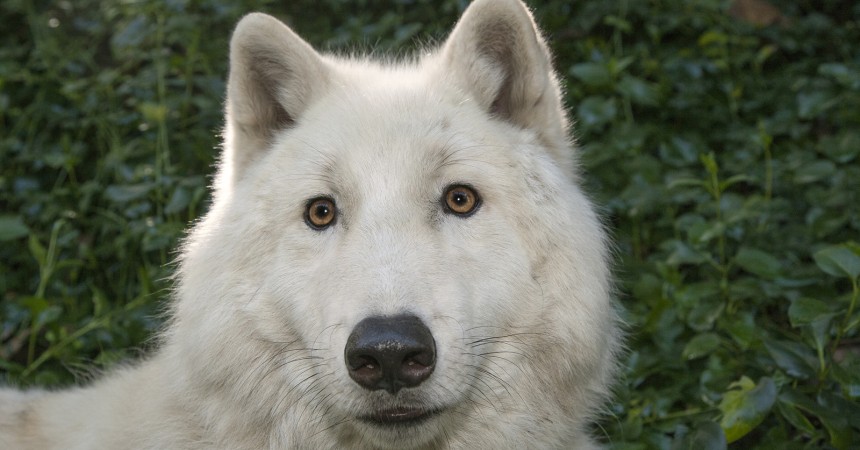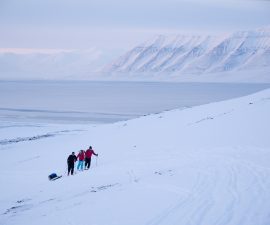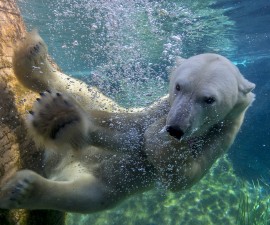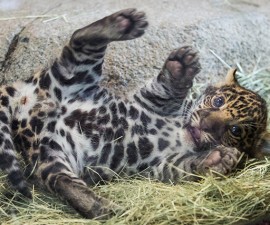With a lot of the US experiencing record cold, and all this talk of another “Polar Vortex,” I thought it would be fun to explore how certain animals deal with extreme cold. Nature has concocted some pretty awesome ways to thrive in cold weather, often involving stylish winter coats, cozy fat insulation, and other clever mechanisms to overcome extreme cold. Check out these animals who absolutely own winter.
Takins have some pretty cool adaptations that help them stay warm and dry during the bitter cold of winter in the rugged Himalayan Mountains. A thick, secondary coat is grown to keep out the chill, which they shed for the summer. Their nose also plays a role in keeping them warm. A takin’s large, moose-like snout has big sinus cavities to warm up the air inhaled before it gets to the lungs. Without this adaptation, takins would lose a large amount of body heat just by breathing.
Polar bears have an outer coat of long guard hairs that stick together when wet and protect a dense, thick undercoat of fur. On land, water rolls right off of the guard hairs. Even though polar bears look white, their hair is really made of clear, hollow tubes filled with air. Scarring or residue on the fur can cause the “white” fur to appear to human eyes as cream colored, yellow, or even pink in the Arctic light. Fat also plays a major role in a polar bear’s ability to survive cold. Fat acts as energy storage when food can’t be found and may provide the ability to generate heat to help insulate polar bears from the freezing air and cold water. This 2-4 inch thick layer of fat may also help the bears float in water. Big is beautiful!
Native to the Arctic region of the Northern Hemisphere, the Arctic Fox has a dense, multi-layered coat that provides excellent insulation against the cold. It also has an impressive layer of fat that provides extra insulation, as well as a a specialized body shape that minimizes exposure to cold. This cleverly adapted canine also has fur on its feet to help it walk on snow and ice without issue.
Snow leopards move to different altitudes along with the summer and winter migrations of their prey animals, so their coats vary from fine in the summer to thick in the winter. Snow leopards have a relatively small head with a short, broad nose that has a large nasal cavity that passes cold air through and warms it. Their huge paws have fur on the bottom that protects and cushions their feet for walking, climbing, and jumping. The wide, furry paws also give the cat great traction on snow.
Reindeer originally inhabited the tundra and forests of Scandinavia and northern Russia and were then introduced into Iceland, Greenland, Alaska, and Canada. They are covered in hair from their nose to the bottom of their feet, and have two coat layers: an undercoat of fine, soft wool that stays right next to their skin, and a top layer of long, hollow guard hairs. The air trapped inside the guard hairs holds in body heat to keep the animal warm against wind and cold. The hollow hairs also help the reindeer float, allowing it to swim across a river, if needed.
Sea lions have a thick, slick, waterproof coat that allows them to glide through cold water with ease and comfort. Their flippers also serve to regulate the sea lion’s body temperature. When it’s cold, specially designed blood vessel in the thin-skinned flippers constrict to prevent heat loss, but when it’s hot, blood flow is increased to these surface areas to be cooled more quickly.
Incredibly adaptable, wolves have inhabited, at one point, virtually all of North America, northern Europe, eastern Africa, and Asia. Employing a wide range of adaptations, wolves tolerate a massive range of temperatures, from -70 to 120 degrees Fahrenheit (-50 to 48.8 degrees Celsius). All of their senses are keen, and they can run, climb, lope, and swim incredibly well.
Lastly, here’s an animal that not only doesn’t wear a winter coat, but is a natural nudist. Yeah, naked mole-rats wouldn’t do so well in extreme cold. Be glad you’re not one of these guys this season. Happy winter everyone!
Matt Steele is the senior social media planner for San Diego Zoo Global. Read his previous post, 5 Turkey Myths Busted.





